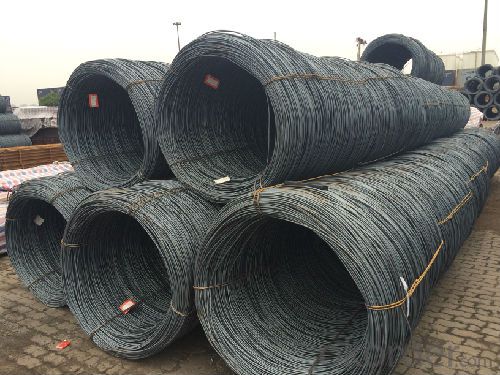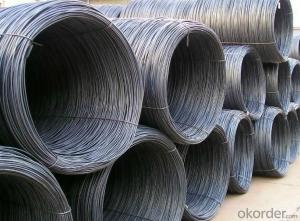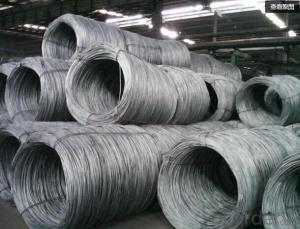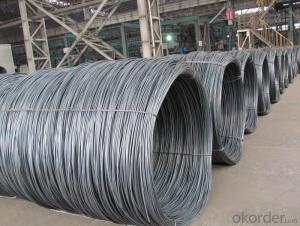Hot Rolled Steel Wire Rod in Coils SAE1008B
- Loading Port:
- Tianjin
- Payment Terms:
- TT OR LC
- Min Order Qty:
- 30 m.t.
- Supply Capability:
- 20000 m.t./month
OKorder Service Pledge
OKorder Financial Service
You Might Also Like
Item specifice
Product Description:
OKorder is offering Hot Rolled Steel Wire Rod in Coils SAE1008B at great prices with worldwide shipping. Our supplier is a world-class manufacturer of steel, with our products utilized the world over. OKorder annually supplies products to African, South American and Asian markets. We provide quotations within 24 hours of receiving an inquiry and guarantee competitive prices.
Product Applications:
Hot Rolled Steel Wire Rod in Coils SAE1008B are ideal for structural applications and are widely used in construction and manufacturing. Carbon steel wire rod is mainly used for reinforcement of reinforced concrete and welded structure or reprocessed (roberts , nail, etc.) materials, especially used to produce wire drawing, welding electrode, nails, spring, electronic, precise machinery parts and so on.
Product Advantages:
OKorder's Hot Rolled Steel Wire Rod in Coils SAE1008B are durable, strong, and wide variety of sizes. They are newly produced by good quality steel billets.
Main Product Features:
· Premium quality
· Prompt delivery & seaworthy packing (30 days after receiving deposit)
· Can be recycled and reused
· Mill test certification
· Professional Service
· Competitive pricing
Product Specifications:
Steel Grade: SAE1006-1018B
Standard: ASTM, GB
Diameter: 5.5mm, 6.5mm, 7mm,8mm,9mm,10mm,12mm,14mm
Type: in coil, coil weight around 2MT
Alloy or Not: Alloy
Technique: Hot Rolled
Place of Origin: China Mainland
Surface: round, no twisted, light and smooth
FAQ:
Q1: Why buy Hot Rolled Steel Wire Rod in Coils SAE1008B from OKorder.com?
A1: All products offered byOKorder.com are carefully selected from China's most reliable manufacturing enterprises. Through its ISO certifications, OKorder.com adheres to the highest standards and a commitment to supply chain safety and customer satisfaction.
Q2: How do we guarantee the quality of our products?
A2: We have established an advanced quality management system which conducts strict quality tests at every step, from raw materials to the final product. At the same time, we provide extensive follow-up service assurances as required.
Q3: How soon can we receive the product after purchase?
A3: Within three days of placing an order, we will arrange production. The normal sizes with the normal grade can be produced within one month. The specific shipping date is dependent upon international and government factors, the delivery to international main port about 45-60days.
Images:


- Q:How is steel wire rod used in the manufacturing of wire ties for construction sites?
- Steel wire rod is an essential component in the manufacturing of wire ties for construction sites. These wire ties are widely used in the construction industry for various purposes, such as securing rebar, reinforcing concrete structures, and fastening construction materials together. The steel wire rod serves as the raw material for producing wire ties. It undergoes a series of processes to transform it into the final product. First, the wire rod is cleaned and coated to enhance its corrosion resistance. This coating, often made of zinc, provides an added layer of protection against rust and ensures the wire tie's longevity in harsh construction environments. Next, the coated steel wire rod is fed into a wire drawing machine where it is pulled through a die to reduce its diameter to the desired size. This process is repeated several times to achieve the required wire thickness and strength. Once the wire is drawn to the desired gauge, it is then cut into appropriate lengths to produce individual wire ties. These lengths can vary depending on the specific application and requirements of the construction project. The wire is then bent, twisted, or formed into the shape of a tie using specialized machinery. Wire ties made from steel wire rod offer exceptional strength, durability, and flexibility. They can be easily bent or twisted to fit around various construction materials, ensuring a secure and tight connection. Moreover, the high tensile strength of steel wire rod ensures that the wire ties can withstand considerable stress and load without breaking or deforming. The wire ties manufactured from steel wire rod are commonly used in construction sites to secure and fasten rebar during concrete pouring. They are also used to reinforce concrete structures, such as walls, columns, and beams. Additionally, wire ties are employed to bundle or tie together construction materials, including pipes, cables, and electrical wires, ensuring proper organization and preventing potential hazards. In summary, steel wire rod plays a crucial role in the manufacturing of wire ties for construction sites. These wire ties provide essential support and reinforcement in various construction applications, offering durability, flexibility, and strength to ensure the safety and stability of construction projects.
- Q:How is steel wire rod used in the manufacturing of wire trellis?
- Steel wire rod is used in the manufacturing of wire trellis as it serves as the primary material for creating the trellis framework. The wire rod is typically shaped into various configurations, such as grids or panels, and welded together to form a sturdy and durable structure. Additionally, the wire rod can be coated or galvanized to enhance its resistance to corrosion and ensure longevity.
- Q:What are the different coatings available for steel wire rod?
- There are various coatings available for steel wire rod, including zinc, galvanized, copper, epoxy, and polyethylene. Each coating offers different benefits such as corrosion resistance, improved durability, and enhanced adhesion properties. The choice of coating depends on the specific application and the desired performance characteristics.
- Q:How is steel wire rod used in the production of reinforcement bars?
- Steel wire rod is used in the production of reinforcement bars by being heated and then rolled into the desired shape and size. This process, known as hot rolling, helps increase the strength and durability of the reinforcement bars. The steel wire rod acts as the core material, providing the necessary tensile strength to the reinforcement bars, which are primarily used to reinforce concrete structures such as buildings, bridges, and highways.
- Q:How are steel wire rods used in the production of wire ropes for cranes?
- Steel wire rods are a crucial component in the production of wire ropes for cranes. These rods serve as the raw material for the wire rope manufacturing process. To begin with, the steel wire rods are carefully selected based on their mechanical properties, such as strength and durability. The rods go through a series of processes, including cleaning, heating, and drawing, to convert them into wire strands. Once the wire strands are formed, they are wound together to create the wire rope. This process involves twisting multiple strands around a central core, usually made of fiber or steel. The wire strands are arranged in a helical pattern, which enhances the strength and flexibility of the wire rope. The steel wire rods used in the production of wire ropes for cranes are specifically chosen for their high tensile strength. This ensures that the wire ropes have the ability to withstand heavy loads and extreme working conditions. The strength of the steel wire rods directly impacts the overall strength and safety of the wire ropes. Additionally, the steel wire rods undergo various quality control measures during the manufacturing process to ensure their reliability and consistency. These measures include testing for tensile strength, breaking load, and other performance parameters. Once the wire ropes are manufactured using the steel wire rods, they are then used in cranes for a variety of applications. Wire ropes are essential for lifting and moving heavy loads, providing stability and control during crane operations. They play a vital role in safely and efficiently lifting, lowering, and suspending loads in various construction, industrial, and maritime settings. Overall, steel wire rods are integral to the production of wire ropes for cranes, as they provide the necessary strength, durability, and reliability required in demanding working environments.
- Q:How are steel wire rods used in the production of screws and bolts for construction?
- Steel wire rods are an essential component in the production of screws and bolts for construction purposes. These rods serve as the raw material for manufacturing these fasteners. To begin with, steel wire rods are first processed through a series of manufacturing steps. They are initially drawn through a series of dies to reduce their diameter and increase their length. This process is known as wire drawing, and it helps in achieving the desired size and strength of the wire rod. Once the wire rods are drawn to the required dimensions, they are then cut into smaller lengths that are suitable for the production of screws and bolts. These lengths are often referred to as blanks or billets. The next step involves the threading of these blanks to create the screw or bolt shape. This threading process is typically done using specialized machines that cut or roll grooves onto the surface of the wire rods. These grooves are what enable the screws and bolts to effectively grip into their respective materials, providing a secure connection. After the threading process, the blanks are further processed to add various features, such as the head shape, drive type (such as slotted, Phillips, or hex), and any additional coatings or finishes required for corrosion resistance. This is typically done through machining or forging processes, depending on the desired specifications of the screws and bolts. Once the screws and bolts are formed, they undergo quality control checks to ensure that they meet the necessary standards for strength, dimensions, and overall functionality. This includes testing for factors like tensile strength, hardness, and dimensional accuracy. Finally, the screws and bolts are packaged and distributed for use in construction projects. These fasteners play a crucial role in joining various components of a structure together, providing stability, strength, and longevity to the overall construction. They are widely used in applications such as framing, fastening walls, securing beams, and connecting various building materials. In summary, steel wire rods are used in the production of screws and bolts for construction by serving as the raw material that is processed, threaded, and shaped into fasteners with specific features and properties. These fasteners are vital for the structural integrity and reliability of construction projects, making steel wire rods a crucial component in the construction industry.
- Q:What are the safety requirements for steel wire rod used in mining wire ropes?
- The safe and reliable operation of mining equipment relies heavily on the safety requirements for steel wire rod used in mining wire ropes. These requirements play a vital role in preventing accidents, injuries, and fatalities that may result from wire rope failure. 1. When it comes to material composition, the steel wire rod for mining wire ropes must be made from high-quality steel with specific properties that can withstand the harsh conditions in mining operations. It is imperative that it possesses a high tensile strength, excellent fatigue resistance, and good ductility. 2. To ensure the wire rod's strength and durability, it must meet specific requirements that enable it to handle the load and stress associated with mining activities. It should be capable of withstanding heavy loads, sudden impacts, and repetitive bending and flexing without exhibiting signs of fatigue or failure. 3. The surface quality of the steel wire rod is of utmost importance. It should be smooth and free from any cracks, deformations, or defects that could compromise the integrity of the wire rope. A rough or uneven surface can lead to increased friction, wear, and potential failures during operation. 4. Dimensional accuracy is crucial for the wire rod to be compatible with other components of the wire rope system. It must adhere to precise dimensional tolerances to ensure proper assembly, fitting, and functionality of the wire rope. 5. Proper heat treatment processes, such as annealing or quenching, should be applied to the wire rod to enhance its mechanical properties. Heat treatment can improve its strength, hardness, and resistance to wear and corrosion, thereby making the wire rope more reliable and durable. 6. Rigorous quality control measures should be in place during the manufacturing process to ensure that the wire rod meets the specified safety requirements. Regular inspections, testing, and certifications should be carried out to verify the material's compliance with industry standards and regulations. 7. Accurate documentation and traceability records are essential for the steel wire rod used in mining wire ropes. This enables proper tracking of the material's origin, manufacturing process, and quality control procedures, ensuring accountability and facilitating necessary investigations or recalls. By adhering to these safety requirements, the integrity and reliability of the equipment are maintained. Regular inspections and maintenance of the wire ropes should also be conducted to ensure their continued safe operation.
- Q:What are the different types of steel wire rod finishes for improved wear resistance in high-temperature environments?
- There are several types of steel wire rod finishes that can enhance wear resistance in high-temperature environments. Some common options include heat treatment, such as quenching and tempering, which improves hardness and toughness. Another method is nitriding, where the surface is enriched with nitrogen to form a hard and wear-resistant layer. Additionally, coatings like ceramic or metallic coatings can be applied to provide an extra layer of protection against wear and corrosion. Overall, these finishes help to optimize the performance and durability of steel wire rods in challenging high-temperature conditions.
- Q:What are the main distribution channels for steel wire rod?
- Steel wire rod is distributed through various channels including manufacturers, wholesalers, retailers, and e-commerce platforms. Manufacturers play a vital role by producing different grades and sizes of steel wire rod. They have their own distribution networks to directly supply the product to wholesalers or retailers. These manufacturers often have sales teams or agents who actively promote and sell their products to potential customers. Wholesalers act as intermediaries by purchasing large quantities of steel wire rod from manufacturers and then distributing it to retailers or other businesses. They have extensive networks and warehouses to efficiently store and transport the product. Wholesalers often offer competitive pricing and bulk discounts, making them an attractive option for retailers and businesses looking to buy steel wire rod in large quantities. Retailers are the final link in the distribution chain, selling steel wire rod directly to end consumers or small businesses. They can be specialized steel suppliers or hardware stores that carry a wide range of products. Retailers provide convenient access to steel wire rod for customers who require smaller quantities or immediate availability. The distribution of steel wire rod has been significantly impacted by the emergence of e-commerce platforms in recent years. Online marketplaces allow manufacturers, wholesalers, and retailers to reach a wider customer base and facilitate direct sales. E-commerce platforms provide convenience, quick delivery, and often offer competitive pricing, making them an increasingly popular choice for buyers. In summary, the main distribution channels for steel wire rod include manufacturers, wholesalers, retailers, and e-commerce platforms. This combination of traditional channels and the growing prominence of e-commerce platforms has transformed the industry.
- Q:What are the different types of steel wire rod coatings available?
- Steel wire rods can be coated with various types of coatings, each offering unique advantages. Some common coatings include: 1. Galvanized Coating: Zinc is applied to the surface of the steel wire rod, providing excellent corrosion resistance. This makes it suitable for outdoor applications or environments with high humidity or exposure to corrosive substances. 2. Phosphating Coating: A chemical conversion process creates a thin layer of phosphate crystals on the surface of the steel wire rod. This coating improves adhesion, corrosion resistance, and acts as a good base for painting or further treatment. 3. Polymer Coating: Polyethylene or polypropylene coatings protect against corrosion, abrasion, and chemical exposure. These coatings are highly flexible and can be customized to meet specific requirements like UV resistance or electrical insulation. 4. Epoxy Coating: Known for exceptional adhesion and chemical resistance, epoxy coatings are commonly used in environments with harsh chemicals, like the oil and gas industry or marine environments. They also protect against corrosion and abrasion. 5. Zinc-Aluminum Coating: This coating involves applying a layer of zinc-aluminum alloy to the steel wire rod. It offers excellent corrosion resistance and is often used in applications requiring both corrosion and heat resistance, such as automotive or construction industries. 6. Copper Coating: Copper coatings are primarily used for their electrical conductivity properties. They enhance conductivity and reduce electrical resistance in steel wire rods used for electrical applications like wiring or cables. These examples highlight the various coatings available for steel wire rods. The selection depends on specific requirements like corrosion resistance, electrical conductivity, or chemical resistance. Choosing the appropriate coating ensures optimal performance and durability of the steel wire rods.
1. Manufacturer Overview |
|
|---|---|
| Location | |
| Year Established | |
| Annual Output Value | |
| Main Markets | |
| Company Certifications | |
2. Manufacturer Certificates |
|
|---|---|
| a) Certification Name | |
| Range | |
| Reference | |
| Validity Period | |
3. Manufacturer Capability |
|
|---|---|
| a)Trade Capacity | |
| Nearest Port | |
| Export Percentage | |
| No.of Employees in Trade Department | |
| Language Spoken: | |
| b)Factory Information | |
| Factory Size: | |
| No. of Production Lines | |
| Contract Manufacturing | |
| Product Price Range | |
Send your message to us
Hot Rolled Steel Wire Rod in Coils SAE1008B
- Loading Port:
- Tianjin
- Payment Terms:
- TT OR LC
- Min Order Qty:
- 30 m.t.
- Supply Capability:
- 20000 m.t./month
OKorder Service Pledge
OKorder Financial Service
Similar products
New products
Hot products
Hot Searches
Related keywords




























